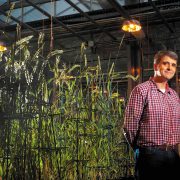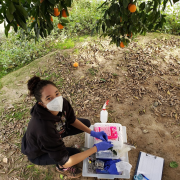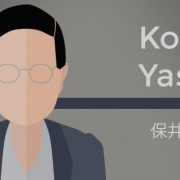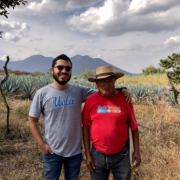Plant Scientist Highlight: Michael Purugganan
 Why did you decide to pursue science as you went through college, and what got you particularly interested in rice stress and plant domestication?
Why did you decide to pursue science as you went through college, and what got you particularly interested in rice stress and plant domestication?
There were two areas I had an aptitude for in college – science and journalism. I was lucky to get experience in both during my college days,. And while journalism was tempting (I was even offered the possibility of being a foreign correspondent for the Associated Press while I was still at university), I decided that it was science I really was most passionate about and where I steered myself towards after graduation.
As to rice, I grew up in the Philippines, where rice is deeply embedded in our food and culture. I was always interested in working in an area that maybe, directly or indirectly, could help benefit developing countries, and working on rice seemed ideal. And domestication – it really allows me to engage in a topic from a multidisciplinary angle. Studying domestication involves plant biology at its core, but also evolutionary biology, genetics, and even archaeology, anthropology and history. I find that fascinating!
You’ve previously working in journalism. Even though it was a while ago, has that experience shaped how you do science and perform you current position?
I think at one level that journalism is like science – both want answers, and both need to report good stories. And if there one thing that my journalist background has taught me, it is the value of telling a good story. I think my training in reporting helps me see the narrative in the data, and helping me communicate it in my writing.
What other values did you learn growing up that you carry into your work today?
There are many values that I think are important, but to me curiosity may be the most valuable. Just being intensely curious, and finding that when you don’t know the answer you have to find out what the answer is. I think curiosity and the desire to find answers is one of the most valuable traits a scientist has.
Starting new projects, challenging current current thinking and paradigms, pioneering new techniques takes a lot of creativity. Where do you find inspiration to tackle these new challenges?
That is always a subject I am fascinated about – how do you nurture creativity? For me, I actively try to read a wide range of subjects and always try to find connections between what appears to be very different areas of research. That to me is the most fun – when I can take ideas from a distant area of science (or indeed any part of human knowledge) and connect it to my work on domestication and evolution. Making those connections give me the most satisfaction. I spend a lot of time daydreaming as well. And you may be surprised to hear that when I want to be inspired, I go to art museums and soak up all the creative energy within their walls. The impressionist wing of New York’s Metropolitan Museum is a particular favorite, as is the entire Museum of Modern Art.
Why did you choose dates for your plant domestication and evolution studies?
It was just an opportunity that presented itself. My university, New York University, was opening a campus in Abu Dhabi in the United Arab Emirates, and I was asked to help establish a research program there. I normally study rice, which of course would be foolhardy to study in the desert environment of the Arabian peninsula. But date palms – it was an important food crop, it was a tree species (and I did not know much about fruit tree domestication), and I knew very little about this species. It was opportunity meeting scientific curiosity, and so we started working in date palms and now we are hooked! It is a fascinating species, and it is teaching me how domestication proceeds in a perennial and the similarities and differences between domestication of trees vs, annual cereal grasses.
What are some examples of some unexpected hurdles you’ve encountered and how did you overcome them?
I am not sure there was one obstacle that stood out – just a lot of obstacles, big and small, that always crop up, that can stop a line of inquiry or cause a project to divert. I do think that overcoming the many obstacles that stand in your way, or finding creative ways around them, is important for a good scientist.
What do you hope to be remembered for in 100 years?
There are three legacies I hope to leave. First, I hope to have advanced our understanding if the evolutionary dynamics associated with domestication, and in so doing help us know in greater detail how crop species are domesticated and, form this, how evolution occurs. Second, I would like to think that our basic research on crop domestication and evolutionary adaptation may help breeders and other plant scientists develop new crops that can help feed the growing world population, and in its own way helps combat hunger, particularly in developing countries. Finally, I hope to be remembered through my students and in turn their students, hoping that those that I have had the honor of helping train in science are themselves making a a difference (and they are making a difference, and I am so proud of them all!)
What is one piece of advice for early-career scientists that you would like to pass on?
I guess it would be to find your own unique niche in science where you think you can make a difference to the science. And your goal should always be to make a major impact, to always be hungry to make a difference.
Thank you again to Dr. Purugganan. More information about his work can be found on his lab page.
Download a copy Purugganan.









